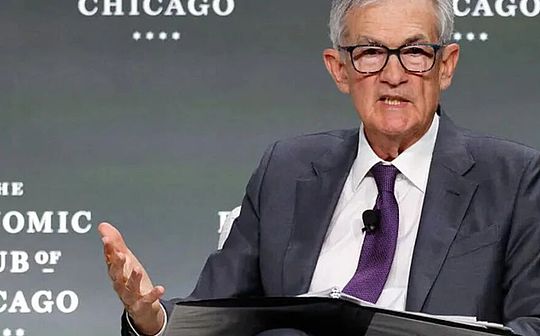
Written by: 0xWeilan, Source: EMC Labs
The information, opinions and judgments mentioned in this report, such as market, projects, currencies, etc. are for reference only and do not constitute any investment advice.
The crypto asset market after March 2024 seems to be passively becoming a second-rate performance with the theme of “waiting”.All the actors, creators and producers seem to have forgotten the plot, plot and original theme, and just stretched their necks to wait for a certain “audience” to enter, and whether there is a hurricane to hit tonight.
From mid-March to the end of August, more than five months have passed, and BTC prices have repeatedly fluctuated in the “new high consolidation zone”.During this period, the global market experienced repeated inflation and downward trends, ambiguous and clear expectations of US dollar interest rate cuts, ulterior speculations about whether the economic soft or hard landings, and the violent market fluctuations caused by trend changes that drove different investors to adjust their positions.
Against this background, some BTC investors in the crypto market conducted their first large-scale sell-off to lock in profits and squeezed out liquidity. During this period, speculation, short selling, panic selling, and changes in risk preference caused by changes in market sentiment..
This is the essence of market movements that we have observed during this period.
After 5 and a half months of bumpyness, the crypto market has entered a low period.Spot liquidity has been greatly reduced, leverage has been cleared, rebound is weak and rebound prices have gradually declined, investors are sluggish, and pessimistic and negative emotions have shrouded in the crypto market.
This is a result of market movement and an internal resistance in the next stage.But in our opinion, the greater resistance lies in the uncertainty of the external market – macro finance, the hidden concerns of the hard landing of the US economy, and the unclear trend of the US equity market.
The crypto market has entered the end of clearing, and the market value and long-term hand distribution have entered a state of accumulation of momentum, and is ready for the upward trend.However, the funds on the market are relatively weak and there is no confidence or ability to make independent choices.
URPD: 2.91 million+BTC repricing
The market has continued to fluctuate over the past eight months. When we look at it on the chain, we can face the orderly results of the chaotic movement.
 Bit Network URPD (3.13)
Bit Network URPD (3.13)
The URPD indicator is used to describe the statistical analysis of all unspent BTC on the price, which can effectively understand the final results of chip allocation.The above figure shows the BTC distribution structure when Bitcoin hit a record high on March 13, when 3.086 million chips were accumulated in the “new high consolidation zone” ($53,000 to $74,000).By the closing price on August 31, the chips distributed in this range reached 6.02 million, which means that at least 2.916 million + BTC had bets in this range in the past five months.

BTC URPD (8.31)
In terms of time, since BTC started to break through the market in mid-October last year and reached its historical high on March 13, the rise time took more than five months.Now it has been more than 5 months in the “new high consolidation zone” and “sideway” consolidation. The highest price during the period was US$72,777 and the lowest price was US$49,050. The band fluctuations occurred more than 7 times.This oscillation formed an exchange of 2.916 million+ chips (the real data is far higher than this, and the data exchanged by centralized exchanges is not fully reflected in the chain), greatly depleting the liquidity of the market.
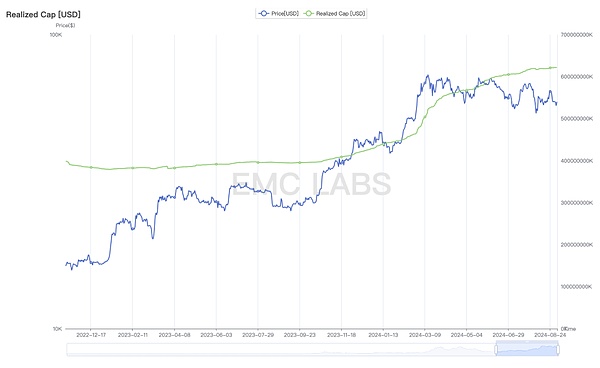
BTC realizes market value
Through the “realization market value” compiled at procurement costs, we can observe that since the market entered the high consolidation zone in March, although the price has not yet risen further, the market value has been achieved, which means a large-scaleCheap chips were repriced during this period.Re-priced BTC can be converted into support or form pressure under certain conditions.
Therefore, we maintain a neutral attitude towards the distribution of URPD. There are indeed enough chips to exchange. Funds of sufficient scale are priced here and are optimistic about the future market, but the nature of these funds is unknown. Whether the support or pressure will be provided to the market in the future will continue.observe.
Long-term and short-term hands: big sell-off and re-cooling
We regard the market cycle as a major turnover for long-term investors and short-term investors in the time dimension, during which each exchanges between BTC and USD.

Long and short handheld positions statistics (weekly)
BTC started the market in mid-October, and the large-scale share reduction of long-term hands began in December. It reached a climax in February and March to push the market to hit a new high during this period, gradually drawing a “new high consolidation zone”.
Since May, the reduction of long-term hands has significantly decreased, and this group has restarted its share increase. The increase in the past seven or eight months has significantly accelerated. From the lowest point to August 31, this group has increased.He held 630,000 BTC.The parties to reduce holdings mainly come from short-handed and miners’ selling.
In our June report, we reminded that the market will have two major sell-offs in each round of bull market, and the second major sell-off will completely drain the market funds and then destroy the bull market.And what has happened in the past few months is just the first sell-off.This sell-off has been around for more than five months, and the results of the on-chain distribution can be clearly seen.
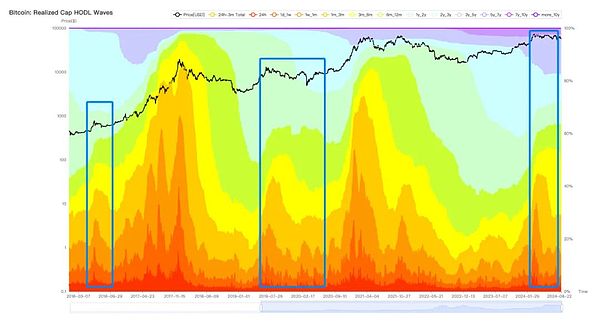
BTC HODL Waves
HODL Waves shows that the new currency has dropped rapidly in March, which means speculative activity has dropped sharply, and the second-largest currency from March to June is also accelerating its downward trend (also an important part of the chips in the new high consolidation zone).Most of these BTC holders enter the market after the ETF approval, and should be “long-term single cycle”.This means that most of the BTC they hold will be converted into long-hand positions, which is a clear proof of the surge in long-hand positions by 470,000 in August.Long hand positions will continue to grow rapidly in the foreseeable months.
The cooling of BTC’s holding structure is the result of BTC’s return from short hand to long hand during the “new high adjustment period”.This shift will significantly reduce market liquidity.The decay of liquidity often drives BTC prices further downward when funds are scarce, and drives prices upward when funds are abundant.
Therefore, we can judge that after more than 5 months of fluctuation and the market is fully prepared, the price trend is mainly determined by the direction of capital flow (rather than internal chip conversion).
Fund flow: funds that are shut down in ETF channel
In the November 2023 report, we proposed that the stablecoin channel funds flow positively in mid-October, which is the first time since February 2022, representing the arrival of a new stage.Since then, BTC has launched a sharp rise.
 Major Stablecoins inflow and outflow statistics (monthly)
Major Stablecoins inflow and outflow statistics (monthly)
In the past five months of adjustments, May and June were the most scarce moments of market capital, with only US$1.201 billion inflows in two months.This pessimism is being reversed, with inflows reaching 2.696 billion and 5.09 billion respectively in July and 8.The entry of these funds shows their recognition of the price of the new high consolidation range and their medium- and long-term optimism for the second half of the bull market.
In January this year, after the approval of 11 BTC ETFs in the United States, funds from this channel began to become an important independent force.In previous reports, we have pointed out many times that the funds in this channel have independent will and will become an important force in pricing BTC due to their size and action.During the panic selling of the German government in July, the BTC ETF channel funds took decisive action and picked up rich and cheap chips.
However, as the US dollar interest rate hike became increasingly confirmed in August, the yen unexpectedly raised interest rates, and arbitrage traders closed their positions fiercely, triggering violent fluctuations in global stock markets, affecting the BTC ETF, which is regarded as a high-risk asset.The continued selling from ETF holders at the beginning of the month caused BTC to fall straight to $49,000, a new low in months and also broke through the lower edge of the “new high consolidation zone”.Subsequently, funds from ETF channels gradually returned (stable coin bottom buying funds also poured in later), the BTC price was pulled back to US$64,000, and by the end of the month, the ETF channel funds returned to flow out, and the BTC price also fell back below US$60,000 again.
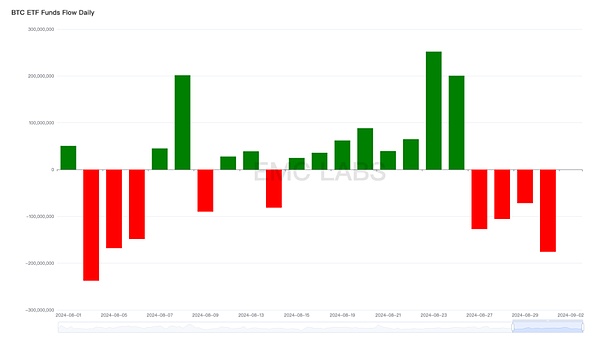 Statistics on overall fund inflows and outflows of 11 BTC ETF Funds in August (Day)
Statistics on overall fund inflows and outflows of 11 BTC ETF Funds in August (Day)
In terms of monthly perspectives, the inflow of funds from BTC ETF channel this month was -72.83 million US dollars, the second worst month in history, only better than April.
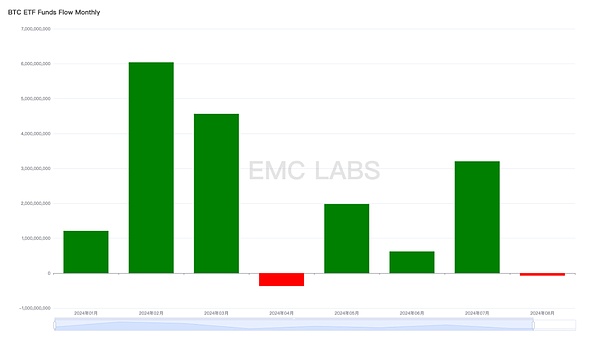 Statistics of overall capital inflows and outflows of 11 BTC ETF Funds (month)
Statistics of overall capital inflows and outflows of 11 BTC ETF Funds (month)
Let’s merge the two funds to see-
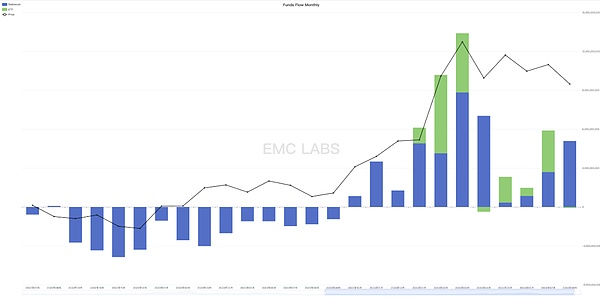 Total inflows and outflows of stablecoins and 11 BTC ETF channels (month)
Total inflows and outflows of stablecoins and 11 BTC ETF channels (month)
Although stablecoins have recorded growth inflows for three consecutive months, ETF channels have recorded outflows this month, leaving the overall inflow of funds in August only US$5 billion, lower than 5.9 billion in July.EMC Labs believes that inflows inflows are the fundamental reason why BTC was able to pull back to $65,000 after the collapse of the big collapse, but the decline in capital inflows has made this month’s high of $65,050 well below July.$70,000.The decline in funds means that the inflow of funds from ETF channels has dropped from 3.2 billion in July to US$72.83 million outflow this month.
The attitude of funds in BTC ETF channels, which are closely connected to the US stock market, has become the most critical factor in determining the market trend.
Salary cut in September: soft landing vs hard landing
Unlike BTC’s weak performance in August, although it also experienced severe fluctuations, the US stock market still showed amazing resilience during the same period.The Nasdaq recorded a monthly gain of 0.65%, while the Dow Jones Industrial Average hit an all-time high.During this period, discussions about whether a rate hike of 25 or 50 basis points in September were rampant, but the real focus of traders is actually the core issue of “will the US economy land softly or hardly.”
According to the current analysis of the US stock trend, EMC Labs believes that the overall market tends to be soft landing for the US economy, so it has not priced the overall downward price under the expectation of a hard landing for the US stock market.Based on the assumption of a soft landing, some funds chose to withdraw from the “Big Seven” that had previously risen sharply (most of them underperformed the Nasdaq this month), while entering other blue-chip stocks with smaller gains pushed the Dow to a record high.
Based on past experience, we tend to judge that US stock market investors regard BTC as a “big seven” asset – although they have a great future, they currently have overvalued risks, so a large-scale sell-off phenomenon occurred, which is related to “seven”The giants’ selling was generally synchronized.However, compared with mainstream funds, the “Big Seven” is much more attractive than BTC, so after the plunge, the rebound of the “Big Seven” is stronger than BTC.
Currently, the probability of CME FedWatch cutting interest rates by 25 basis points in September is 69%, and the probability of cutting interest rates by 50 basis points is 31%.
EMC Labs believes that if the 25-point rate cut in September is settled and there are no major economic and employment data that indicate that the economy does not meet the characteristics of a “soft landing”, U.S. stocks will run steadily. If the Big Seven Repairs Upward, then BTC ETFs will likely return to positive.Inflows drive BTC upward and hit the psychological threshold of $70,000 again and even challenge new highs.If there are major economic and employment data that indicate that the economy does not meet the characteristics of “soft landing”, US stocks will most likely correct downward, especially the seven giants. The corresponding BTC ETF channel funds are likely to not be optimistic. If BTC is downward, it may challenge again.$54,000 at the lower edge of the “new high recovery period”.
This speculation is based on the assumption that stablecoin channel funds will not experience trend changes in September.In addition, we are cautious about stablecoins. Although funds in this channel are accumulating, we tend to be difficult to push BTC out of its independent market.The most optimistic forecast is that under the background of the upward revision of the seven giants, stablecoins and ETF channels are inflowing funds simultaneously to drive BTC upward.If so, breaking through the previous high will have a high probability of success.
Conclusion
BTC broke through $54,000 in January this year, hitting a record high in March, and began volatile consolidation in the “new high consolidation zone” in April. It has been more than May so far, and has been close to the continuous increase since September last year. In terms of time, it is approaching.Trend turning point.
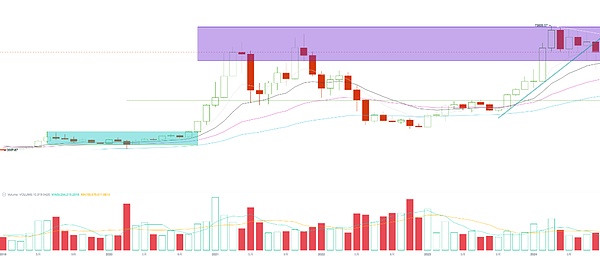
BTC monthly trend chart
This should also be the reason why funds in the stablecoin channel are gradually gathering and reshaping their buying power.
However, the real breakthrough still depends on the positive settlement of macro finance and core US economic data, and the subsequent mainstream US stock funds poured into the BTC ETF channel.
Due to the reentry of the US dollar, September has become the most important month of this year, and the US stock and crypto markets will give preliminary answers this month.






